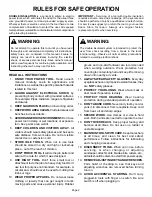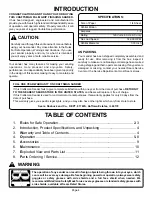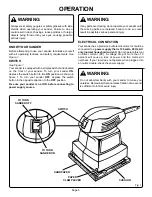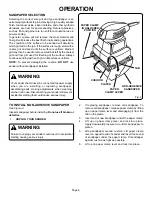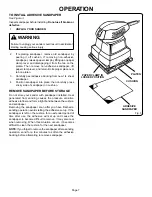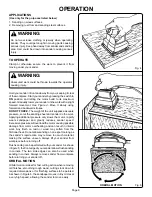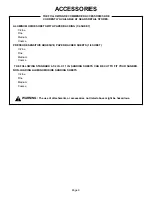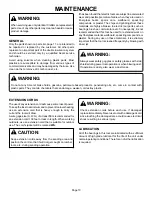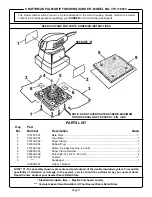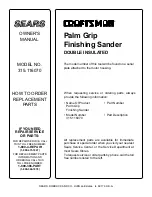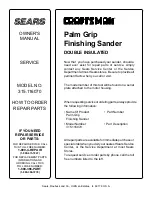
Page 2
RULES FOR SAFE OPERATION
DOUBLE INSULATION is a concept in safety, in electric
power tools, which eliminates the need for the usual three
wire grounded power cord and grounded supply system.
Wherever there is electric current in the tool there are two
complete sets of insulation to protect the user. All exposed
metal parts are isolated from internal metal motor components
with protecting insulation.
IMPORTANT - Servicing of a tool with double insulation
requires extreme care and knowledge of the system and
should be performed only by a qualified service technician.
For service we suggest you return the tool to your nearest
Sears Store for repair. Always use original factory
replacement parts when servicing.
WARNING:
Do not attempt to operate this tool until you have read
thoroughly and understand completely all instructions,
safety rules, etc. contained in this manual. Failure to
comply can result in accidents involving fire, electric
shock, or serious personal injury. Save owner's manual
and review frequently for continuing safe operation, and
instructing others who may use this tool.
READ ALL INSTRUCTIONS
1. KNOW YOUR POWER TOOL. Read owner's
manual carefully. Learn its applications and
limitations as well as the specific potential hazards
related to this tool.
2. GUARD AGAINST ELECTRICAL SHOCK by
preventing body contact with grounded surfaces.
For example: Pipes, radiators, ranges, refrigerator
enclosures.
3. KEEP GUARDS IN PLACE and in working order.
4. KEEP WORK AREA CLEAN. Cluttered areas and
benches invite accidents.
5. AVOID DANGEROUS ENVIRONMENT. Don't use
power tool in damp or wet locations or expose to
rain. Keep work area well lit.
6. KEEP CHILDREN AND VISITORS AWAY. All
visitors should wear safety glasses and be kept a
safe distance from work area. Do not let visitors
contact tool or extension cord.
7. STORE IDLE TOOLS. When not in use tools
should be stored in a dry and high or locked-up
place - out of the reach of children.
8. DON'T FORCE TOOL. It will do the job better and
safer at the rate for which it was designed.
9. USE RIGHT TOOL. Don't force small tool or
attachment to do the job of a heavy duty tool. Don't
use tool for purpose not intended - for example - A
circular saw should never be used for cutting tree
limbs or logs.
10. WEAR PROPER APPAREL. Do not wear loose
clothing or jewelry that can get caught in tool's
moving parts and cause personal injury. Rubber
gloves and non-skid footwear are recommended
when working outdoors. Wear protective hair
covering to contain long hair and keep it from being
drawn into nearby air vents.
11. ALWAYS WEAR SAFETY GLASSES. Everyday
eyeglasses have only impact-resistant lenses; they
are NOT safety glasses.
12. PROTECT YOUR LUNGS. Wear a face mask or
dust mask if operation is dusty.
13. PROTECT YOUR HEARING. Wear hearing
protection during extended periods of operation.
14. DON'T ABUSE CORD. Never carry tool by cord or
yank it to disconnect from receptacle. Keep cord
from heat, oil and sharp edges.
15. SECURE WORK. Use clamps or a vise to hold
work. Both hands are needed to operate the tool.
16. DON'T OVERREACH. Keep proper footing and
balance at all times. Do not use on a ladder or
unstable support.
17. MAINTAIN TOOLS WITH CARE. Keep tools sharp
at all times, and clean for best and safest
performance. Follow instructions for lubricating
and changing accessories.
18. DISCONNECT TOOLS. When not in use, before
servicing, or when changing or adjusting
sandpaper, attachments, blades, bits, cutters, etc.,
all tools should be disconnected from power supply.
19. REMOVE ADJUSTING KEYS AND WRENCHES.
Form habit of checking to see that keys and
adjusting wrenches are removed before turning
tool on.
20. AVOID ACCIDENTAL STARTING. Don't carry
plugged-in tools with finger on switch. Be sure
switch is off when plugging in.
WARNING:
The double insulated system is intended to protect the
user from shock resulting from a break in the tool's
internal wiring. Observe all normal safety precautions
related to avoiding electrical shock.


